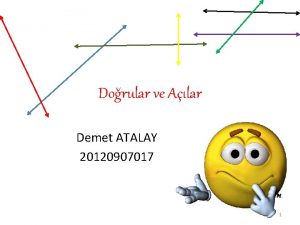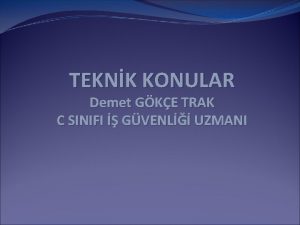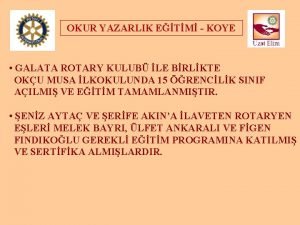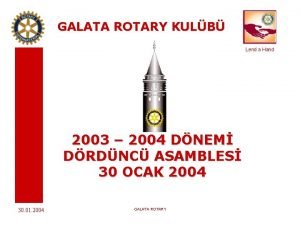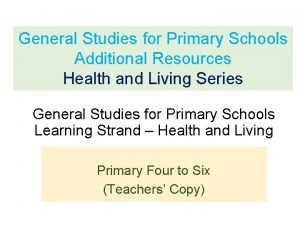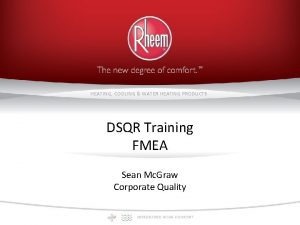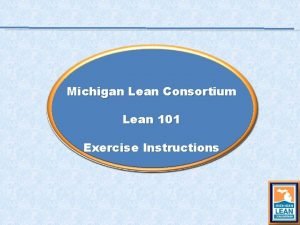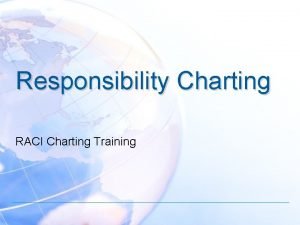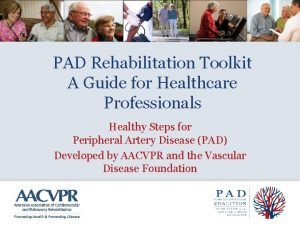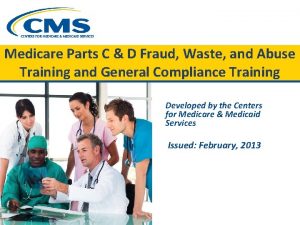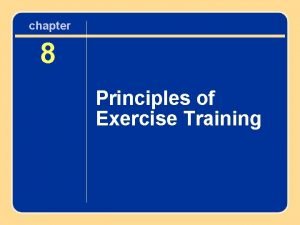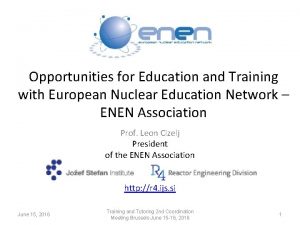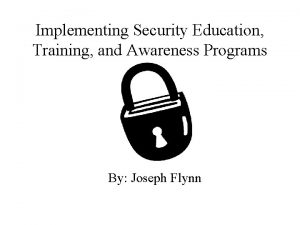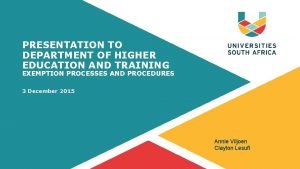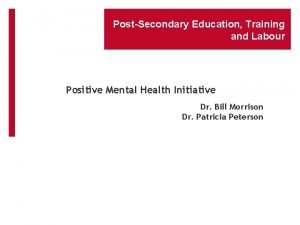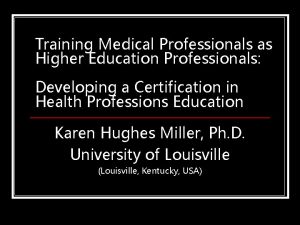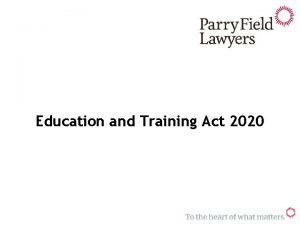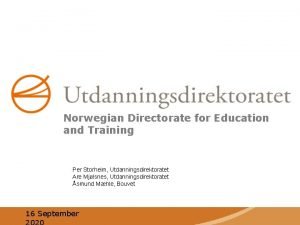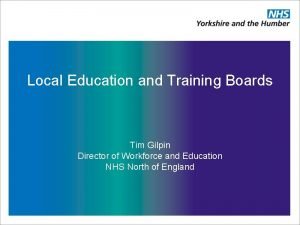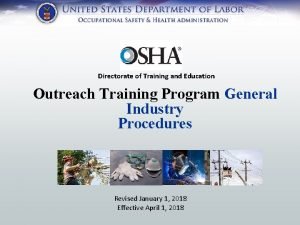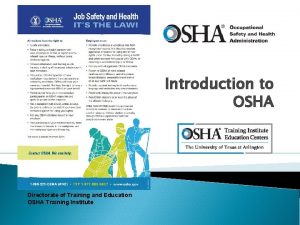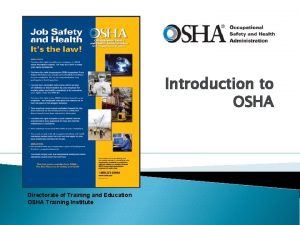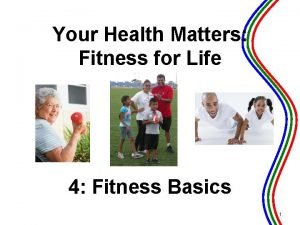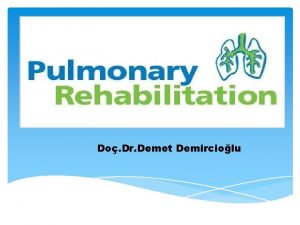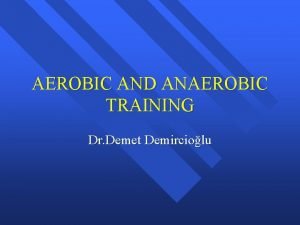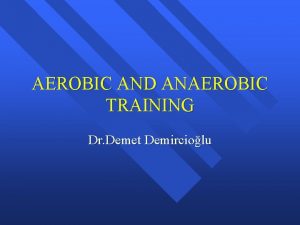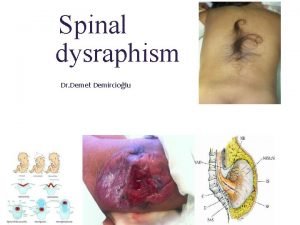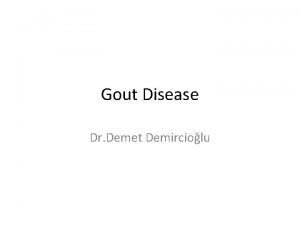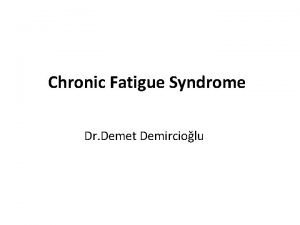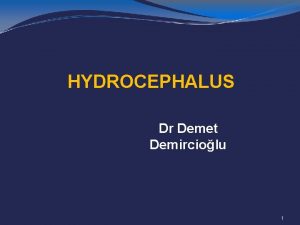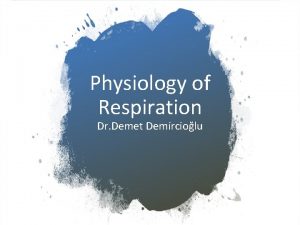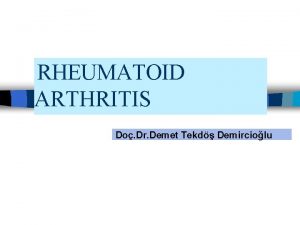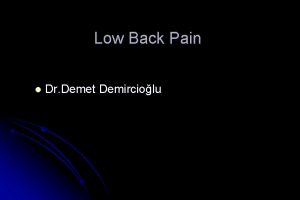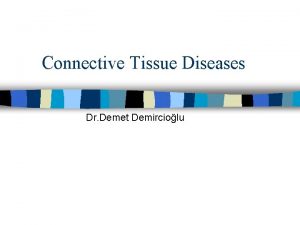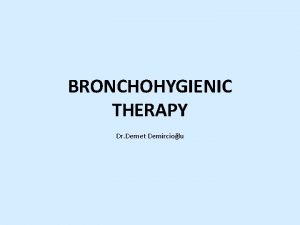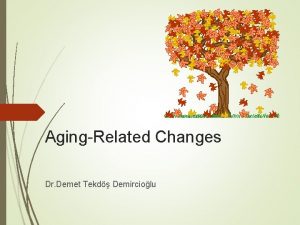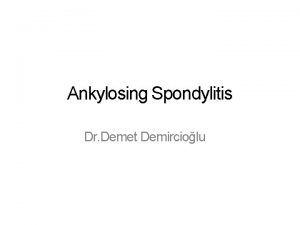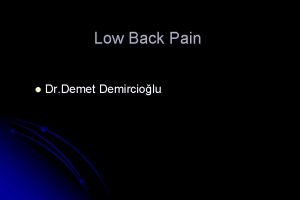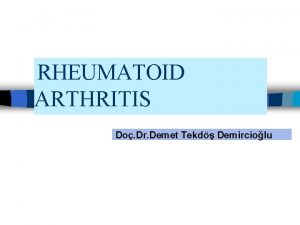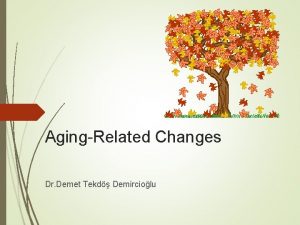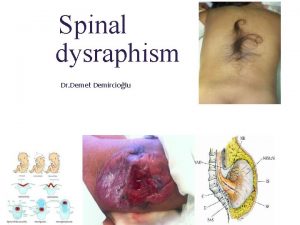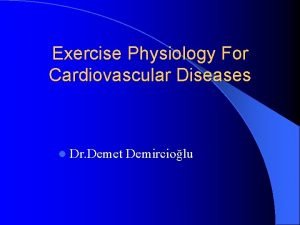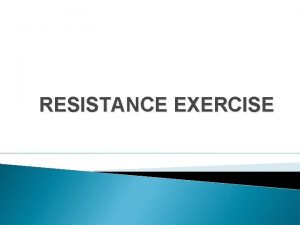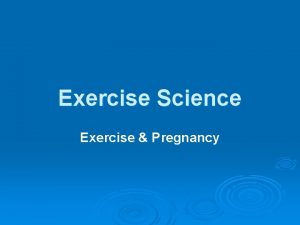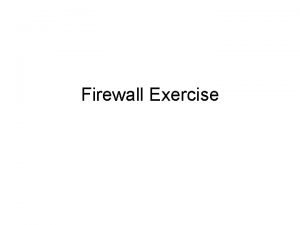Do Dr Demet Demirciolu Education General exercise training












































- Slides: 44

Doç. Dr. Demet Demircioğlu

Education General exercise training Psychological support Pulmonary Rehabilitation components Nutritional advice Breathing Retraining Outcome Assessment

PATHOPHYSIOLOGY

Consequences of Respiratory Disease • Peripheral Muscle dysfunction • Respiratory muscle dysfunction • Nutritional abnormalities • Cardiac impairment • Skeletal disease • Sensory defects • Psychosocial dysfunction

Mechanisms for these morbidities • • Deconditioning Malnutrition Effects of hypoxemia Steroid myopathy or neuropathy Hyperinflation Diaphragmatic fatigue Psychosocial dysfunction from anxiety, guilt, dependency and sleep disturbances

Goals of Pulmonary Rehabilitation Aims to reduce symptoms, decrease disability, increase participation in physical and social activities and improve overall quality of life. These goals are achieved through patient and family education, exercise training, psychosocial intervention and assessment of outcomes. The interventions are geared toward the individual problems of each patient and administered by the multidisciplinary team.

Benefits of Pulmonary Rehabilitation Improved Exercise Capacity Reduced perceived intensity of dyspnea Improve health-related QOL Reduced hospitalization and LOS Reduced anxiety and depression from COPD Improved upper limb function Benefits extend well beyond immediate period of training

Patient Selection �Obstructive Diseases �Restrictive Diseases �Interstitial �Chest Wall �Neuromuscular �Other Diseases Chronic Obstructive Pulmonary Disease (COPD) patients at all stages of disease appear to benefit from exercise training programs improving with respect to both exercise tolerance and symptoms of dyspnea and fatigue (GOLD)

Exclusion criteria Patients with severe orthopedic or neurological disorders limiting their mobility Severe pulmonary arterial hypertension Exercise induced syncope Unstable angina or recent MI Refractory fatigue Inability to learn, psychiatric instability and disruptive behavior

Setting for Pulmonary Rehabilitation Outpatient Inpatient Home Community Based Choice varies depending on - Distance to program - Insurance payer coverage - Patient preference - Physical, functional, psychosocial status of patient

Education EXAMPLES OF EDUCATIONAL TOPICS Breathing Strategies Normal Lung Function and Pathophysiology of Lung Disease Proper Use of Medications, including Oxygen Bronchial Hygiene Techniques Benefits of Exercise and Maintaining Physical Activities Energy Conservation and Work Simplification Techniques Eating Right

Education…… Irritant Avoidance, including Smoking Cessation Prevention and Early Treatment of Respiratory Exacerbations Indications for Calling the Health Care Provider Leisure, Travel, and Sexuality Coping with Chronic Lung Disease and End-of-Life Planning Anxiety and Panic Control, including Relaxation Techniques and Stress Management

Exercise training Benefits of Exercise training Pathophysiological abnormality Benefits of exercise training Decreased lean body mass Increases fat free mass Decreased TY 1 fibers Normalizes proportion Decreased cross sectional area of muscle fibers Increases Decreased capillary contacts to muscle fibers Increases Decreased capacity of oxidative enzymes Increased inflammation No effect Increased apoptotic markers No effect Reduced glutathione levels Increases Lower intracellular p. H, increased lactate levels and rapid fall in p. H on exercise Normalization of decline in p. H

Exercise training Components of exercise training: • Lower extremity exercises • Upper extremity exercises • Ventilatory muscle training Types of exercise: • Endurance or aerobic • Strength or resistance

Lower extremity exercise Walking Treadmill Stationary bicycle Stair climbing Sit & Stand

Upper Extremity. Training Arm cycle ergometer Unsupported arm lifting Lifting weights Strength exercise When strength exercise was added to standard exercise protocol; led to greater increase in muscle strength and muscle mass

Ventilatory muscle training Resistive Inspiratory Training (IMT): Patient breaths through hand held device with which resistance to flow can be increased gradually Threshold IMT: Patient breaths through a device equipped with a valve which opens at a given pressure. • Difficult to standardize the load • Easily quantitated • Patients may hypoventilate and standardized • Leads to increased Pulmonary Arterial Pressure and fall in oxygen tension

Resistive IMT

Threshold IMT Device

Chest Physical Therapy & Breathing Retraining Pursed Lip Breathing – shifts breathing pattern and inhibits dynamic airway collapse. Posture techniques – forward respiratory leaning reduces abdominal effort and elevating depressed diaphram by shifting. reduces respiratory contents Diaphragm Breathing – Some patients with extreme air trapping and hyperinflation have increased WOB with this technique Postural Draining – valuable in patients who produce more than 30 cc/24 hours - Coughing techniques

Pursed Lip Flutter Device

Bronchial hygiene techniques Postural drainage Percussion & vibration Directed cough Forced expiratory technique (huff cough) Active cycle of breathing Autogenic drainage Positive expiratory pressure

What does ATS-ERS & GOLDSay? A minimum of 20 sessions should be given At least three times per week Twice weekly supervised plus one unsupervised home session may also be acceptable. Once weekly sessions seem to be insufficient Each session to last 30 minutes High-intensity exercise (>60% of maximal work rate) produces greater physiologic benefit and should be encouraged; however, low-intensity training is also effective for those patients who cannot achieve this level of intensity (American Thoracic Society (ATS) – European

ATS-ERS Both upper and lower extremity training should be utilized Lower extremity exercises like treadmill and stationary bicycle ergometer & Arm exercises like lifting weights and arm cycle ergometer are recommended The combination of endurance and strength training generally has multiple beneficial effects and is well tolerated; strength training would be particularly indicated for patients with significant muscle atrophy Respiratory muscle training could be considered as adjunctive therapy, primarily in patients with suspected or proven respiratory muscle weakness

The minimum length of an effective rehabilitation program is 6 weeks. Daily to weekly sessions Duration of 10 minutes to 45 minutes per session Intensity of 50% of VO 2 max to maximum tolerated Endurance training can be accomplished through continuous or interval exercise programs. The latter involve the patient doing the same total work but divided into briefer periods of high-intensity exercise, which is useful when performance is limited by other comorbidities

Additional considerations Optimal bronchodilator therapy should be given prior to exercise training to enhance performance. Patients who are receiving long-term oxygen therapy should have this continued during exercise training, but may need increased flow rates. Oxygen supplementation during pulmonary rehabilitation, regardless of whether or not oxygen desaturation during exercise occurs, often allows for higher training intensity and/or reduced symptoms in the research setting. (ATS/ERS STATEMENT)

Neuromuscular electrical stimulation (NMES) NMES may be an adjunctive therapy for patients with severe chronic respiratory disease who are bed bound or suffering from extreme skeletal muscle weakness ATS/ERS Guidelines

Non invasive mechanical ventilation Because NPPV is a very difficult and labor-intensive intervention, it should be used only in those with demonstrated benefit from this therapy Further studies are needed to further define its role in pulmonary rehabilitation. ATS/ERS guidelines

Nutritional Interventions Why intervene? High prevalence and association with morbidity and mortality Higher caloric requirements from exercise training in pulmonary rehabilitation, which may further aggravate these abnormalities (without supplementation) Enhanced benefits, which will result from structured exercise training.

Body composition abnormalities Increased activity related Energy expenditure Hyper metabolic state Decreased intake Impairment of Energy balance Imbalance in Protein synthesis and breakdown Loss of fat; Loss of weight : BMI < 21 • 10% weight loss in 6 months • 5% weight loss in 1 month

Caloric supplementation Should be considered if : BMI less than 21 kg/m 2 Involuntary weight loss of >10% during the last 6 months or more than 5% in the past month Depletion in FFM or lean body mass.

Nutritional supplementation Energy dense foods Well distributed during the day No evidence of advantage of high fat diet Patients experience less dyspnea After carbonhydrate supplement than fat rich supplement. (prabably due to delayed gastric emptying Daily protein intake should be 1. 5 gm/kg for positive balance

What to give……. Small Frequent Meals High-calorie snackscreamy, rich puddings, crackers withpeanut butter, dried fruits and nuts. Beverages- milk-shakes, regular milk and high-calorie fruit juices, Breads and Cereals Pep up Your Protein- milk or soy protein powder to mashed potatoes, gravies, soups and hot cereal Choose High-Calorie Fruits- bananas, mango, papaya, dates, dried apples or apricots instead of apples, watermelon Remember Your Vegetables potatoes, beets, corn, peas, carrots Healthy, Unsaturated Fats Soups and

Nutritional Interventions Physiological intervention: Strength exercise Addition of strength training lead to increase in strength and mid thigh circumference (measured by CT) Pharmacological intervention : Anabolic steroids Nandrolone decanoate- 50 mg for male; 25 mg for females; 2 Weekly for 4 doses Anabolic therapy alone increases muscle mass but not exercise capacity

Nutritional Interventions Growth hormone rh. GH 0. 05 mg/kg for 3 weeks in addition to 35 Kcal/kg and 1 gm protein/kg per day has shown to increase fat free mass But does not improve muscle strength or exercise tolerance ( hand grip and maximal exercise ) and no change in well being of the patient.

Nutritional Interventions Testosterone 100 mg weekly for ten weeks in men with low testosterone levels 320 ng/ml showed weight gain of 2. 3 kg Addition of exercise to testosterone has augmented weight gain to 3. 3 kg Physiological consequences and long term effects not studied

What the Guidelines. Say…. . Increased calorie intake is best accompanied by exercise regimes that have a nonspecific anabolic action Anabolic steroids in COPD patients with weight loss increase body weight and lean body mass; but have little or no effect on exercise capacity. (GOLD) Pulmonary rehabilitation programs should address body composition abnormalities. Intervention may be in the form of caloric, physiologic, pharmacologic or combination therapy. (ATS/ERS STATEMENT)

Psychological considerations Screening for anxiety and depression should be part of the initial assessment. Mild or moderate levels of anxiety or depression related to the disease process may improve with pulmonary rehabilitation Patients with significant psychiatric disease should get appropriate professional care.

Outcome Assessment Providing patients with an opportunity to give feedback about the program is a useful measure of quality control. Patient feedback also allows coordinators to evaluate the components of pulmonary rehabilitation that patients find most useful. The questionnaire should also provide patients with a variety of answering options Exercise capacity measurement

Maintenance rehabilitation & Repeat rehabilitation program Current guidelines does not comment on maintenance & repeat rehabilitation Yearly repeat rehabilitation program had shown: Short term benefits in the form of less frequent exacerbations but no long term physiological effects on exercise tolerance, dyspnea & HRQL Foglio K. Chest. 2001; 119: 1696– 1704

Pulmonary Rehab. in Resource Poor Settings Assess the patient with spirometry, saturation, 6 MWT, weight/FFMI by biometric impedance, and bone density by sonography, AQ 20 and PHQ questionnaire Treatment of osteoporosis and dietary advice by the physician Exercise training by the physician or a trained staff, or an assistant at the time of enrolment for 30 minutes The exercise should simulate the patient’s home environment The endurance and strength training can be done by walking/ cycling, walking uphill/climbing stairs and

Pulmonary Rehab in Resource Poor Settings……. . The exercise should be guided by his ability to tolerate exercise and 6 MWT with periods of rest if desired. The speed and distance should be increased gradually The patient can be educated about breathing techniques by the physician/assistant The patients should exercise twice in a day for 30 minutes for at least 5 to 6 days in a week The patient may be given a diary to maintain The patient may follow up once in a week or 15 days for reinforcement/increment/supervision of exercises


 Demet atalay
Demet atalay Demet gökçe
Demet gökçe Demet midillioğlu
Demet midillioğlu Demet midillioğlu
Demet midillioğlu Primary 4 general studies worksheet
Primary 4 general studies worksheet Fmea training exercise
Fmea training exercise Standard work training exercise
Standard work training exercise Raci training
Raci training Pad exercise training toolkit
Pad exercise training toolkit Planos en cinematografia
Planos en cinematografia Where did general lee surrender to general grant?
Where did general lee surrender to general grant? General ledger accounting training
General ledger accounting training Downstream entity examples
Downstream entity examples Principles of training program
Principles of training program Qeco portal
Qeco portal General education harvard
General education harvard General education movie
General education movie Training is expensive without training it is more expensive
Training is expensive without training it is more expensive Metode of the job training
Metode of the job training Aggression replacement training facilitator training
Aggression replacement training facilitator training Ecetp.pdp.albany.edu.elearning
Ecetp.pdp.albany.edu.elearning Education in sparta and athens
Education in sparta and athens Education vs training
Education vs training Security education training and awareness seta program
Security education training and awareness seta program Department of higher education and training
Department of higher education and training Post secondary education training and labour
Post secondary education training and labour Education and training career cluster definition
Education and training career cluster definition Training for higher education professionals
Training for higher education professionals Education and training 2010
Education and training 2010 Education and training act 2020 summary
Education and training act 2020 summary Vocational education & training in uae
Vocational education & training in uae Etf qtls
Etf qtls Norwegian directorate for education and training
Norwegian directorate for education and training Tim gilpin
Tim gilpin Community colleges in south africa
Community colleges in south africa Osha directorate of training and education
Osha directorate of training and education Absa bond holiday
Absa bond holiday Osha directorate of training and education
Osha directorate of training and education Osha directorate of training and education
Osha directorate of training and education Geothermal education and training
Geothermal education and training Education and training 2010
Education and training 2010 Is als a non formal education
Is als a non formal education 10 difference between health education and health promotion
10 difference between health education and health promotion Types of extension education
Types of extension education Light to moderate exercise
Light to moderate exercise
